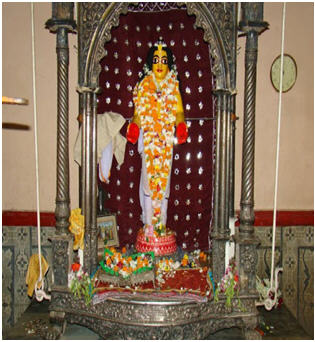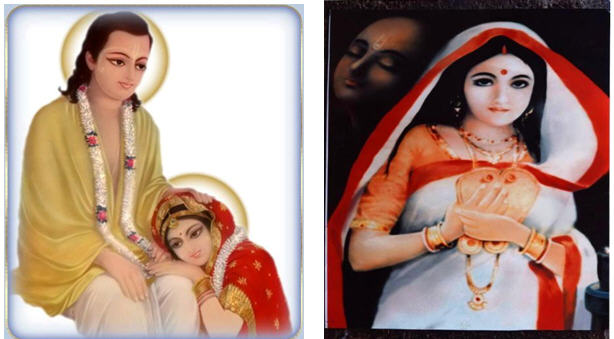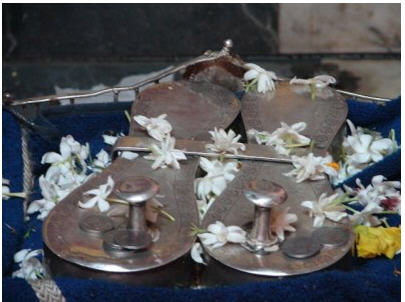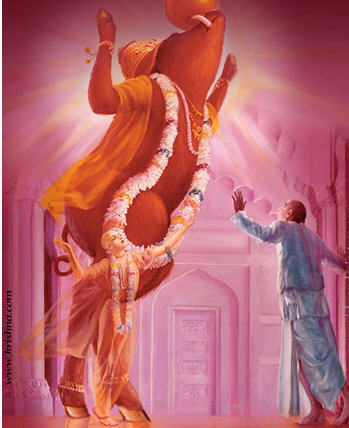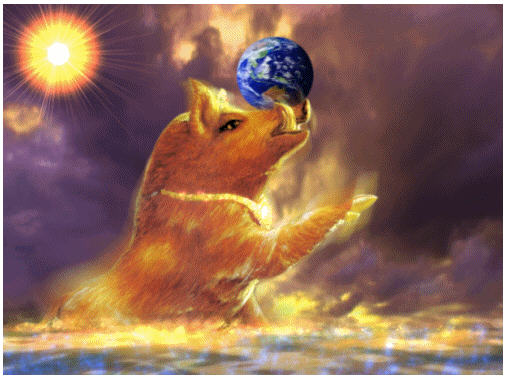Koladvipa is also called Aparadha-bhanjana Kuliya, or “Kuliya, the place where offences are destroyed”. After taking sannyasa, Sriman Mahaprabhu went to Sri Puri-dhama. He travelled for some time in South India and then returned to Puri. Later He travelled again, this time to take darsana of Sridhama Vrindavana. Thousands of people accompanied Him as He passed through places such as Panihati, Kumarahatta and Kancanapalli, until He finally arrived at Vidya-vacaspati’s house in Vidyanagara. The crowds were so great that for seven days Mahaprabhu stayed in Madhava dasa’s house in Kuliya. While He was here, He delivered Gopala Capala, a resident of Kuliya, who was an offender to both the Vaishnavas and the holy name, and Devananda Pandita, who also offended the Vaishnavas. Gopala Cakravarti was a government tax collector who worked under Sri Hiranya and Govardhana Majumdara, the well-known residents of Saptagrama. He was highly scholarly and very beautiful. One day the royal priest, Balarama Pandita, went with Srila Haridasa Thakura to the royal court of Sri Hiranya and Govardhana. Srila Haridasa Thakura proceeded to glorify the holy name saying, “What to speak of uttering one pure name, the utterance of a mere semblance of the holy name – spoken to indicate something else (sanketa), jokingly (parihasa), disrespectfully (avahela), derisively (stobhaavajna) or inattentively (upeksha) – can easily bestow liberation. Pure chanting of the holy name awards krishna-prema by which one attains Vaikuntha or above that, Sri Goloka-dhama.” Haridasa Thakura’s statements greatly angered Gopala, who contemptuously insulted him: “Liberation is attained only by jnana; it can never be attained by harinama. If one can attain liberation by chanting the holy name, then let my nose rot and fall off, otherwise, if Haridasa’s statement is wrong, let his nose rot and fall off.” A tumult broke out in the assembly. Balarama Pandita said, “You have offended the exalted Vaishnava Haridasa Thakura. There will never be any auspiciousness for you. You have guaranteed your own destruction due to your terrible offence to a Vaishnava.” After this incident Govardhana dasa dismissed Gopala Cakravarti from his service. And although the maha-bhagavata Srila Haridasa Thakura, the personification of forgiveness and tolerance, did not accept Gopala’s offence, Gopala became afflicted by leprosy three days after the incident. His beautiful campaka-flower-like nose, his fingers and his toes rotted away. After many days Sriman Mahaprabhu came to Kuliya-grama and Gopala Cakravarti went to see Him. Weeping, he surrendered to the supremely merciful Mahaprabhu and begged forgiveness for his vaishnava-aparadha. Caitanya Mahaprabhu forgave this nama-aparadhi brahmana and instructed him to continuously chant the holy name. Gopala Cakravarti did so and his leprosy soon disappeared leaving him beautiful as before. Now, he was Bhagavan’s devotee, highly dedicated to the holy name, and a servant of the Vaishnavas.
Another resident of Navadvipa named Gopala Capala was a depraved brahmana. He became so envious of Srivasa Pandita that he could not tolerate the sankirtana at Srivasa’s house and tried to disturb him in different ways. At night he placed at Srivasa’s door many items used in the worship of the goddess Durga, such as a wine pot and vermilion, to show that Srivasa was only externally posing as a Vaishnava. Srivasa Pandita had them removed and purified the place by smearing it with cow dung. Due to this great offence Gopala Capala soon became afflicted with leprosy. When, after accepting sannyasa, Sriman Mahaprabhu came to Kuliya, Gopala Capala came to Him and falling at His feet, began to weep. Mahaprabhu told him to beg forgiveness from Srivasa Pandita. He fell weeping at Srivasa Pandita’s feet and by the mercy of Mahaprabhu, his health returned.
At that time in Navadvipa, Devananda Pandita was considered a great teacher of Srimad-Bhagavatam and he instructed many students in his home in Kuliya-nagara on the Ganga’s western bank. Once, the maha-bhagavata Srivasa Pandita passed by Devananda Pandita’s house and heard Srimad-Bhagavatam being recited. He went in and sat down to listen. As Devananda Pandita described Krishna’s pastimes, Srivasa Pandita was unable to remain calm. He wept loudly and rolled on the ground. Devananda Pandita’s students, who were devoid of bhava- bhakti, could not understand Srivasa Pandita’s ashta-sattvika bhavas. Considering him a disturbance to their studies, they threw him out of the house. Devananda Pandita remained silent, doing nothing to stop them. When news of this incident came to Sri Caitanya Mahaprabhu He angrily said, “Devananda does not understand a single letter of the Bhagavatam, which is Sri Krishna personified and completely transcendental, so what can he teach! Srimad-Bhagavatam can not even remain near him. He is an offender of both Vaishnavas and the Bhagavatam. I will tear up his false Bhagavatam and throw it away.” Some time later, Devananda Pandita met Sri Pundarika Vidyanidhi, one of Sriman Mahaprabhu’s associates. Vidyanidhi mercifully gave him lucid instructions on philosophical knowledge about the devotees, Bhagavatam and the Supreme Lord. He revealed to Devananda Pandita many confidential truths about Sriman Mahaprabhu and Srivasa Pandita. Remembering his previous behaviour Devananda Pandita became filled with remorse. When Sri Caitanya Mahaprabhu came to Kuliya after accepting sannyasa, Devananda Pandita came before Him and in great humility, repeatedly begged forgiveness for his offence. Sriman Mahaprabhu told him to beg pardon from Srivasa Pandita directly. Devananda approached Srivasa Pandita, an incarnation of Naradaji, the personification of mercy. Srivasa forgave all his offences and requested Mahaprabhu to show Devananda Pandita mercy. This He did, and thus made him qualified to attain love of God.
When the teacher Nimai Pandita was living in Sri Navadvipadhama, the prominent professors and students there opposed Him and ridiculed His devotional mood. For the welfare of these ignorant people bereft of bhakti, Nimai Pandita left Navadvipa and took sannyasa. Now, having understood His glory, the teachers and students repented. When Nimai Pandita returned as Sri Krishna Caitanya Mahaprabhu to Kuliya-nagara (after accepting sannyasa), they all came to Madhava dasa’s house to see him. Weeping they begged forgiveness at His feet,and the supremely merciful Mahaprabhu pardoned them. From that time, they all became devotees.
Because these pastimes took place here, Kuliya-grama is known as Aparadha-bhanjana-pata, “the place where offences are destroyed”.
